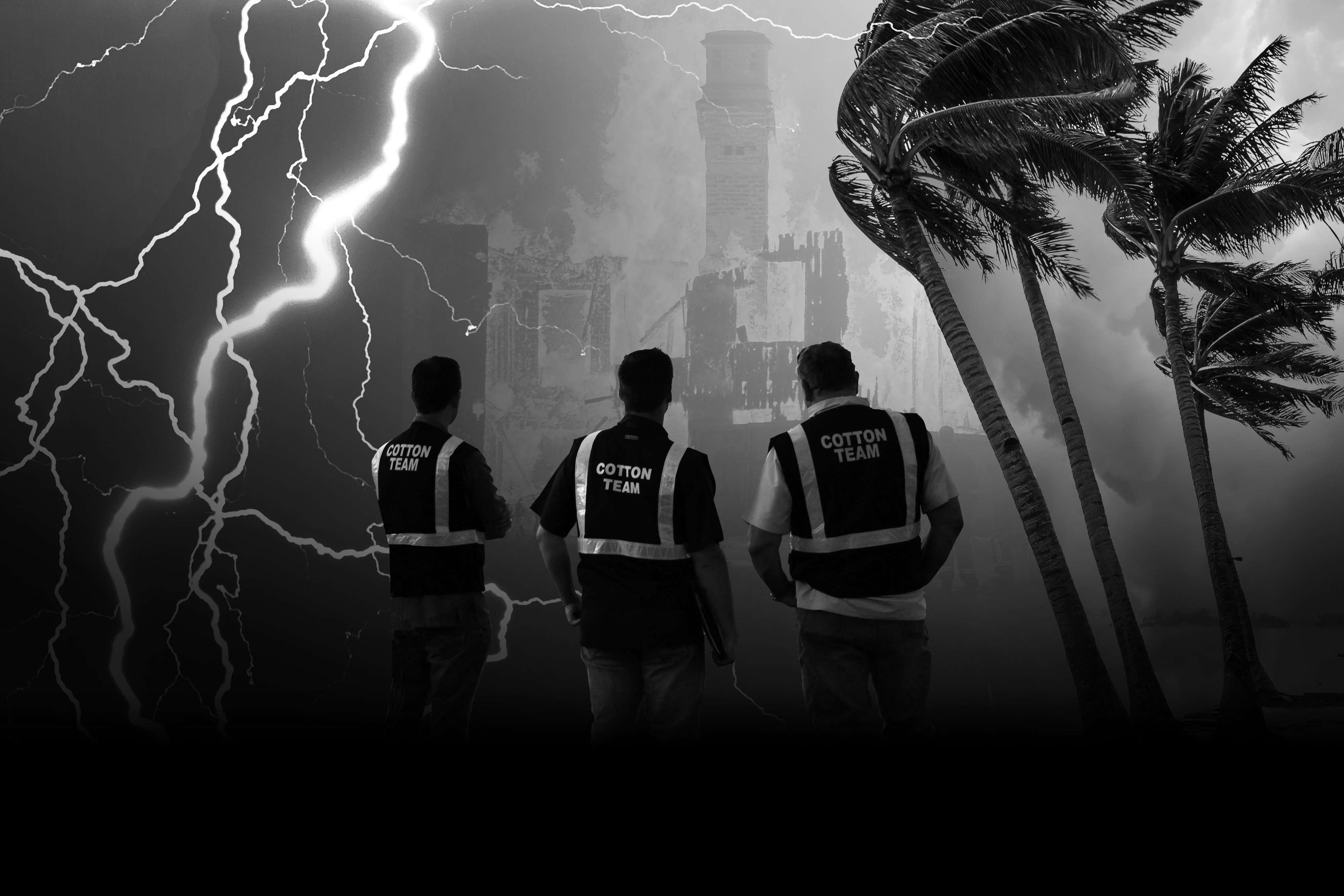
Disaster What To Do's
Chemical Spill
BEFORE
Make sure individuals handling chemicals are trained in the proper use, storage and disposal of them.
Plan ahead by consulting with a disaster recovery company regarding business continuance and recovery of property.
Purchase Protective Equipment (PPE) and breathing apparatus for use by those working most closely with chemicals.
DURING
In the event of large spill in the area and told to shelter in place, go indoors, turn off HVAC system and seal all windows and doors.
Listen to emergency broadcast stations for instructions.
AFTER
Evacuate immediate area as quickly as possible and assemble occupants at a safe distance.
Inform emergency services that there has been a potentially hazardous chemical spill.
Engage a full-service disaster recovery firm to assess the damage, develop a scope of work, liaise with insurers and carry out necessary services. www.cottoncompanies.com
Earthquake
BEFORE
Learn about your area's seismic building standards before beginning new construction.
Know where and how to shut off utilities.
Bolt and brace large furniture, water heaters, gas appliances and heavy equipment to wall studs or floors.
DURING
Take shelter under furniture or other sound structure away from windows until earthquake ceases.
AFTER
Take shelter under furniture or other sound structure away from windows until earthquake ceases.
Carefully evacuate after shaking has stopped, avoiding hazardous obstacles and power sources; use stairs rather than elevators.
Extinguish small fires as these are common after an earthquake
Shut off utilities.
Do not re-enter building until a professional has inspected damage and confirmed it is safe to do so.
Engage a full-service disaster recovery firm to assess the damage, develop a scope of work, liaise with insurers and carry out necessary services. www.cottoncompanies.com
Fire
BEFORE
Check existing fire-fighting equipment and notification systems to ensure they are functioning properly.
Carry out regular fire drills.
Post building diagrams in common areas and make sure exits are clearly marked.
Ask local fire departments to inspect commercial buildings.
Keep important documents and valuables in a fireproof cabinet.
Plan ahead by consulting with a disaster recovery company regarding business continuance and recovery of property
DURING
Call 911
Evacuate immediately to designated safe area. Do not re-enter the building.
Stay out of affected buildings until release is given by the fire department.
AFTER
Secure affected property to protect salvageable contents
Engage a full-service disaster recovery firm to assess the damage, develop a scope of work, liaise with insurers and carry out necessary services. www.cottoncompanies.com
Flood
BEFORE
Know the difference between a flash flood watch and warning.
Move vehicles away from flood zone or to upper levels of parking garages.
Run elevators to an upper floor and cycle doors shut.
If there is advance notice of potential flooding, relocate valuable or sensitive material offsite or to a higher elevation.
Plan ahead by consulting with a disaster recovery company regarding business continuance and recovery of property.
DURING
Once evacuated, stay away from affected area until flood waters recede and authorities deem it safe to return.
Report contamination and hazardous spills to authorities
Remove all items that have been wet for more than 24 hours to prevent mold growth.
Engage a full-service disaster recovery firm to assess the damage, develop a scope of work, liaise with insurers and carry out necessary services. www.cottoncompanies.com
Hurricane
BEFORE
Monitor weather reports closely and follow the orders of local authorities regarding evacuation
Store computers, business records and other important items in a safe area on upper levels and away from windows
Where possible, place storm shutters on windows and protect doors
Plan ahead by consulting with a disaster recovery company regarding business continuance and recovery of property
DURING
If remaining on property take shelter in a secure area with no windows above sea level
Listen to emergency broadcast stations for instructions and remain in shelter until storm winds have subsided
AFTER
Wait until the all-clear has been given by building management or emergency services before reentering the area or property
If necessary, secure the facility to prevent looting
Shut off all gas
Engage a full-service disaster recovery firm to assess the damage, develop a scope of work, liaise with insurers and carry out necessary services. www.cottoncompanies.com
Landslide
BEFORE
Be alert for signs of earth movement in and around the building, such as cracking, broken pipes and tilting of walls or vegetation
Consult a geotechnical expert to assess the likelihood of a landslide and the possibility of installing preventive measures
Plan ahead by consulting with a disaster recovery company regarding business continuance and recovery of property
DURING
If there is sufficient time, evacuate personnel from the building. If not, move to the highest part of the building
Move away from the path of the slide or debris flow
AFTER
Do not re-enter the affected area
Watch for flooding and monitor emergency broadcast stations
Engage a full-service disaster recovery firm to assess the damage, develop a scope of work, liaise with insurers and carry out necessary services. www.cottoncompanies.com
Tornado
BEFORE
Know the difference between a tornado watch and warning
Make sure employees a familiar with the signal to head to safe area
Pay close attention to weather
Plan ahead by consulting with a disaster recovery company regarding business continuance and recovery of property
DURING
Take shelter in a secure area with no windows on a low floor or in a basement
Monitor emergency broadcast stations for instructions
AFTER
Remain in shelter until given the all-clear
If a hissing noise or odor of natural or propane gas is detected, leave property immediately and get to safe distance, call fire department using a cellular phone
Engage a full-service disaster recovery firm to assess the damage, develop a scope of work, liaise with insurers and carry out necessary services. www.cottoncompanies.com
Winter
BEFORE
Monitor weather advisories and follow advice regarding travel
Assemble emergency supply kits for any personnel left in the building
Shut off water to avoid burst pipes and drain system
Maintain heating equipment with repairs and annual inspection
Plan ahead by consulting with a disaster recovery company regarding business continuance and recovery of property
Unplug non-essential electrical equipment
DURING
Monitor accumulation of snow on roofs as this could jeopardize integrity and cause to collapse
Keep personnel off and away from roof lines
AFTER
When safe to evaluate, conduct property damage assessment
Report power outages and downed electrical lines to supply company
Engage a full-service disaster recovery firm to assess the damage, develop a scope of work, liaise with insurers and carry out necessary services. www.cottoncompanies.com
